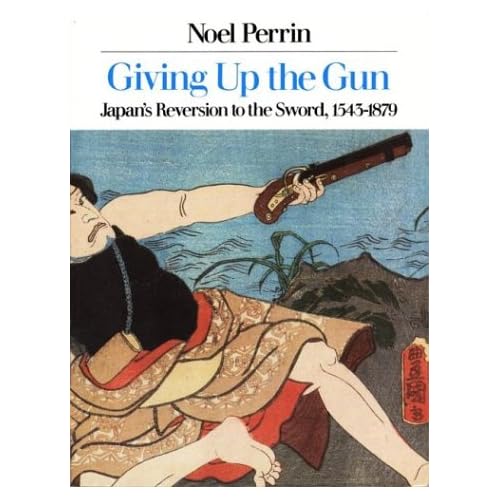 SensibleOpenSource | This book takes a look at the society and the values this culture had to revert a technology that was unhealthy for the whole, the whole of society, environment and respect for life. The contrasts drawn in other societies throughout Europe also consider this technology an issue. However, the controlling of guns from these countries was from stance of oppression. Further, the control was not for the good of society with respect for life and the environment as a whole. It was simply, a control of power, in most cases government. The lack of focus on the proper control and Western Modernity propagates this unbalance. Even today, the majority of countries, Japan, inclusive, creates weapons that endanger human, environment and life with such intense focus the loss of their import is diminished by the weapon technology's shadow.
SensibleOpenSource | This book takes a look at the society and the values this culture had to revert a technology that was unhealthy for the whole, the whole of society, environment and respect for life. The contrasts drawn in other societies throughout Europe also consider this technology an issue. However, the controlling of guns from these countries was from stance of oppression. Further, the control was not for the good of society with respect for life and the environment as a whole. It was simply, a control of power, in most cases government. The lack of focus on the proper control and Western Modernity propagates this unbalance. Even today, the majority of countries, Japan, inclusive, creates weapons that endanger human, environment and life with such intense focus the loss of their import is diminished by the weapon technology's shadow.The author brings you through the Japanese history as well as accounts for other countries throughout the correposnding times. The few pictures present the reader with the reality of the nature in which the Japanese viewed the world of war and guns. Much like the art of swordsmanship for the Samurai. The greatest of all waste was tht a simple peasent, from a safe distance, could take the life of a highly Skilled, inteligent Samurai with very little practice. Not that dying by the sword in warfare was any better than with artillary. The rate in which killing could occur was staggering and to these people the first glimpse of WMD's were more destrcutive then any could imagine, at their time.
The greatest thought is that the 1.2M High Sumari and the 500,000 Low Samurai consumed the destruction, understood the cause and came to the conclusion that removal of this technology was far better for the whole. The reversioning to an older technology for the good of society. Could we do that today? Ever? With Nukes? It's a very interesting thought and one our leaders should contemplate with no disregard.
What would the Sumari think of carpet bombing, bunker busters or nukes?
Con
Pubmed | This delightful essay by Dartmouth English professor Noel Perrin indirectly challenges the relentless advance of science and technology by recounting a unique historical period in which one emergent technology was eschewed by a society favoring maintenance of the status quo ante. The author, without resort to allegory or polemic, gently cajoles his reader with an exemplary story-the story of firearms, or the lack of them, in Tokugawa Japan. This appealing episode ought to be evaluated, as the author insists, not solely by scholars of Japan, but by the rank-and-file of the scientific establishment. The thrust of Mr. Perrin's argument is to rebut by historical deposition the notion favored by many scientists that scientific revelation can never be ignored nor can its application for good or evil be held in abeyance. Indeed, our belief in the "manifest destiny" of scientific discovery has gained the weight of a law of thermodynamics.
Yet for over two centuries, from about 1637 to 1867, nearly the entire period in which feudal Japan was ruled from Edo (Tokyo) by the Tokugawa shoguns, the feudal lords (daimyo) and warrior class (bushi) ignored or disparaged the gun (matchlock) as a combat weapon. In Japan the sword was preeminent from the Shimabara Rebellion of 1637 to the Satsuma Rebellion of 1877-twenty-five years after Perry reintroduced Western firearms. This was a conscious choice not dictated by natural resources or skills in their manufacture or use. Mr. Perrin's thesis is that this period in the history of Japan, in which she was involved not at all with the outside world and banned Western Christianity, provides de facto evidence that mankind can turn his back on technological advance-if only he wishes.
Despite the charm and sincerity of this essay, its usefulness as an object lesson would necessitate a utopian vision that the author himself suggests in a postscript. Tokugawa Japan was the antithesis of utopian. Japan's turning away from guns was both aesthetic and pragmatic-the ruling class did not like them or need them-in fact, they were subversive. Japan "gave up the gun" shortly after its abortive occupation of Korea (1592-1598) and Shimabara Rebellion (1637), the "Alamo" of Christianity in Japan. It eagerly rearmed during its renewal of contact with the West (1852-1877) just before and during the Meiji Restoration. Nevertheless, it was precisely the same internal forces that determined both events. The sword and the dagger were endowed with ritual that marked the power of the bushi class, the samurai warrior, and noblesse oblige. Japan's first large-scale use of the gun in Korea was by the enlisted peasant-class soldiers (ui-samurai), not the samurai warriors. Soon after the Tokugawa shogun recognized that such "egalitarian" warfare was a dangerous, internal threat. In the great "Sword Hunt of 1597" Tokugawa Hideyoshi had the peasant class turn in all its weapons to be melted down to construct a statue to Buddha-a clever Machiavellian ploy.


0 comments:
Post a Comment